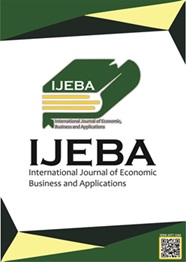The Effect of Business Risk, Firm Size and Good Corporate Governance on Company Performance with Capital Structure as an intervening variable (Empirical Study on companies listed in the Business-27 Index on the IDX for the 2016-2020 period)
Abstract
ABSTRACT: This study aims to analyze the effect of business risk, company size, good corporate governance on company performance and analyze the indirect effect of business risk, company size, good corporate governance on company performance with capital structure as an intervening variable. The population of this study includes all companies that are members of the Bisnis-27 index as many as 27 companies. The sampling technique used purposive sampling method with the number of samples that met the criteria as many as 14 companies. Partial Least Square (PLS) is used as a method to analyze the data that has been obtained. The results showed that firm size and good corporate governance had a significant effect on capital structure, while business risk had no effect on capital structure. Business risk, company size, and good corporate governance have no effect on company performance. For indirect testing, it is proven that company size and good corporate governance have an indirect effect on company performance through capital structure as an intervening variable, while business risk has no effect on company performance through capital structure as an intervening variable.
Keywords
Full Text:
PDFReferences
References
Abdillah, W, and Jogiyanto. (2015). Partial Least Square (PLS). Yogyakarta: Andi
Adinda, F.Z. and Sugianto, S. (2020), “Profitability, Liquidity and Business Risk on Capital Structure”, … National Economic Research …, pp. 462–473.
Anggraini, Y. (2018), “The Influence of Firm Size, Ownership Structure and Growth Opportunity on Company Performance With Capital Structure As Intervening Variable (Case Study on Companies Listed in the Sri-Kehati Index for the Period 2012-2017)”, Faculty of Economics and UIN Jakarta Business.
Brigham, E.F. and Houston. (2010), Fundamentals of Financial Management (Essential of Financial Management), edited by Akbar, Y.A., 11th ed., Salemba Empat, Jakarta.
Erosvitha, C.K.L. and Wirawati, N.G.P. (2016), “Effect of Profitability, Investment Opportunity Set, Sales Growth and Business Risk on Capital Structure”, E-Journal of Accounting, Udayana University, Vol. 14 No. 1, pp. 172–197.
Fawaid, A., Fathoni, A. and Amboningtyas, D. (2019), “Debt to Equity Ratio calculation”, Applied Management and Business, No. 2016, pp. 11–36.
Gitman, J. L. (2006). Principles of Managerial Finance, 10th edition.
Hanafi, F. M. (2012). Financial Management. Publisher BPFE-Yogyakarta.
Halim, E.H., Tanjung, A.R. and Riadi, R. (2011), “The Influence of Earnings Management, Financial Performance and Company Size on the Corporate Perception Index and its Implications for Corporate Social Responsibility (RM Riadi, Amries Rusli Tanjung & Edyanus Herman Halim)”, pp. 1–12.
Handayani, M., Efni, Y. and Ahmad Fauzan Fathoni. (2014), “Effect Investment Decision And Financing Decision In Mediation By Firm Value Of Risk On Firm Value (Studies In Miscellaneous Manufacturing Industries Period 2008-2012)”, Online Journal of Students of the Faculty of Economics, University of Riau, Vol. 1 No. 2, pp. 1–15.
Herlambang, A.R., Halim, E.H. and Haryetti. (2017), “The Effect of Free Cash Flow and Financial Leverage on Earnings Management With Good Corporate Governance as Moderating Variables”, JOM Fekon, Vol. 4 No. 01, pp. 118–134.
Jensen, M., C., and Meckling. (1976). Theory of the Firm: Managerial behavior, agency cost, and ownership structure. Journal of Finance Economics, 3, 305-360.
Ningsih, S. and Utami, W.B. (2020), “The Effect of Operating Leverage and Capital Structure on Financial Performance in Go Public Companies in the Property and Real Estate Sector”, Journal of Accounting and Taxes, Vol. 20 No. 2, available at: https://doi.org/10.29040/jap.v20i2.754.
Nita Septiani, N.P. and Suaryana, I.G.N.A. (2018), “Effect of Profitability, Firm Size, Asset Structure, Business Risk and Liquidity on Capital Structure”, E-Journal of Accounting, Vol. 22, p. 1682.
Nugroho, V. and Nicholas, N. (2020), “Factors Affecting Corporate Financial Performance in Property and Real Estate Companies”, Journal of Accounting Development, Vol. 7 No. 1, pp. 67–69.
OECD (2004). The OECD Principles of Corporate Governance. France: Organization for Economic Co-operations and Development (OECD) Publications Service.
Prasinta, D. (2012), “Accounting Analysis Journal The Effect of Good Corporate Governance on Financial Performance”, Accounting Analysis Journal, Vol. 1 No. 2, pp. 1–7.
Ratmana Putra, I. (2013), "Analysis of the Effect of Operating Leverage and Financial Leverage on Earning Per Share (EPS) in Property Companies listed on the IDX (2007-2011)", Journal of Management Science (JIM), Vol. 1 No. 1.
Tamarani, L., Efni, Y. and Haryetti. (2015), “The Influence of Good Corporate Governance Index and Financial Distress on Company Value with Company Performance as an Intervening Variable”, Jom Fekon, Vol. 01 No. 01, pp. 1–15.
Widiyanti, M. and Elfina, F. (2015), “The Effect of Financial Leverage on Profitability in Automotive and Component Sub-Sector Companies Listed on the Indonesia Stock Exchange”, Sriwijaya Journal of Management and Business, Vol. 13 No. 1, pp. 117–136.
DOI: http://dx.doi.org/10.31258/ijeba.7.1.21-38
Refbacks
- There are currently no refbacks.





.png)
.png)
.png)


